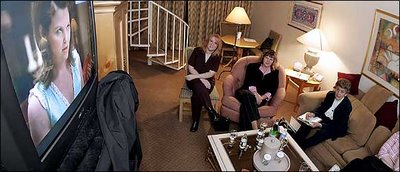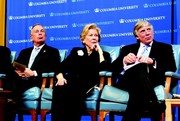http://www.nytimes.com/2006/03/31/us/31divide.htmlBlacks Turn to Internet Highway, and Digital Divide Starts to CloseBy
MICHEL MARRIOTTPublished: March 31, 2006
African-Americans are steadily gaining access to and ease with the Internet, signaling a remarkable closing of the "digital divide" that many experts had worried would be a crippling disadvantage in achieving success.
Skip to next paragraphEnlarge This Image Erik S. Lesser The New York Times Jazmyn Johnson, 9, recently helped her mother, Barbara, use their high-speed DSL Internet connection at their home in Duluth, Ga.
Jazmyn Johnson, 9, recently helped her mother, Barbara, use their high-speed DSL Internet connection at their home in Duluth, Ga.
Robert Spencer for The New York Times

Marlon Orozco, left, a mentor at a Boston program that introduces computer technology to young people with limited access to it. Civil rights leaders, educators and national policy makers warned for years that the Internet was bypassing blacks and some Hispanics as whites and Asian-Americans were rapidly increasing their use of it.
But the falling price of laptops, more computers in public schools and libraries and the newest generation of cellphones and hand-held devices that connect to the Internet have all contributed to closing the divide, Internet experts say.
Another powerful influence in attracting blacks and other minorities to the Internet has been the explosive evolution of the Internet itself, once mostly a tool used by researchers, which has become a cultural crossroad of work, play and social interaction.
Studies and mounting anecdotal evidence now suggest that blacks, even some of those at the lower end of the economic scale, are making significant gains. As a result, organizations that serve African-Americans, as well as companies seeking their business, are increasingly turning to the Internet to reach out to them.
"What digital divide?"
Magic Johnson, the basketball legend, asked rhetorically in an interview about his new Internet campaign deal with the Ford Motor Company's Lincoln Mercury division to use the Internet to promote cars to black prospective buyers.
The sharpest growth in Internet access and use is among young people. But blacks and other members of minorities of various ages are also merging onto the digital information highway as never before.
According to a Pew national survey of people 18 and older, completed in February, 74 percent of whites go online, 61 percent of African-Americans do and 80 percent of English-speaking Hispanic-Americans report using the Internet. The survey did not look at non-English-speaking Hispanics, who some experts believe are not gaining access to the Internet in large numbers.
In a similar Pew survey in 1998, just 42 percent of white American adults said they used the Internet while only 23 percent of African-American adults did so. Forty percent of English-speaking Hispanic-Americans said they used the Internet.
Despite the dissolving gap, some groups like the Intel Computer Clubhouse Network, which introduces digital technologies to young people, say the digital divide is still vast in more subtle ways. Instant messaging and downloading music is one thing, said Marlon Orozco, program manager at the network's Boston clubhouse, but he would like to see black and Hispanic teenagers use the Internet in more challenging ways, like building virtual communities or promoting their businesses.
Vicky Rideout, vice president of the Henry J. Kaiser Family Foundation, which has studied Internet use by race, ethnicity and age, cautioned that a new dimension of the digital divide might be opening because groups that were newer to the Internet tended to use less-advanced hardware and had slower connection speeds.
"The type and meaningful quality of access is, in some ways, a more challenging divide that remains," Ms. Rideout said. "This has an impact on things like homework."
In addition, Internet access solely at institutions can put students at a disadvantage. Schools and other institutions seldom operate round the clock, seven days a week, which is especially an issue for students, said Andy Carvin, coordinator for the Digital Divide Network, an international group that seeks to close the gap.
But not everyone agrees that minorities tend toward less-advanced use of the Internet. Pippa Norris, a lecturer on comparative politics at
Harvard who has written extensively about the digital divide, said members of minorities had been shown to use the Internet to search for jobs and to connect to a wide variety of educational opportunities.
"The simple assumption that the Internet is a luxury is being disputed by this group," Ms. Norris said.
The divide was considered so dire a decade ago that scholars, philanthropists and even President
Bill Clinton in his 1996 State of the Union address fretted over just what the gap would mean in lost educational and employment opportunities for young people who were not wired.
In an effort to help erase the divide, the federal government has provided low-cost connections for schools, libraries, hospitals and health clinics, allocated money to expand in-home access to computers and the Internet for low-income families and given tax incentives to companies donating computer and technical training and for sponsoring community learning centers.
As a result of such efforts, "most kids, almost all kids, have a place in which they can go online and have gone online," said Ms. Rideout of the Kaiser foundation.
Jason Jordan of Boston is one of the young people closing the divide. Jason, 17, who is black, is getting a used computer from an older brother. He said he had wanted a computer for years, since "I heard about a lot that I was missing."
Jason said he had access to the Internet at school, where he is pursuing a general equivalency diploma, but looked forward to having his own computer and Web access at his home in the Dorchester section of Boston. "I can work in my own place and don't have to worry about the time I'm online," he said.
Like Jason, almost 9 out of 10 of the 21 million Americans ages 12 to 17 use the Internet, according to a report issued in July by the Pew Internet and American Life Project. Of them, 87 percent of white teenagers say they use the Internet, while 77 percent of black teenagers and 89 percent of Hispanic teenagers say they have access to it, the report said.
The gap in access among young Americans is less pronounced than among their parents' generation, said Susannah Fox, associate director of the Pew project. "Age continues to be a strong predictor for Internet use," Ms. Fox said.
While, overall Internet use among blacks still significantly trails use among whites, the shrinking divide is most vividly reflected in the online experience of people like Billy and Barbara Johnson. Less than two years ago, the Johnsons, who are black, plugged into the Internet in their upscale suburban home near Atlanta for the first time. Mrs. Johnson, a 52-year-old mother of four and homemaker, said she felt she had little choice because her school-age children needed to use the Internet for research.
And then there is e-mail. "No one really wants to take the time anymore to pick up the phone and keep in touch," lamented Mrs. Johnson, who said that so much of the communications with her children's school was done through e-mail correspondence. "I felt like I was pretty much forced into it."
Even so, Mrs. Johnson said her husband, an assistant coach for the Atlanta Falcons, still chided her when she neglected to check her e-mail at least every day.
Ms. Norris and other experts on Internet use see progress on the horizon. They note that the declining cost of laptop and other computers, and efforts, like those in Philadelphia, to provide low-cost wireless Internet access, are likely to increase online access for groups that have been slow to connect.
Philanthropic efforts have also helped to give more people Internet access. For example, the Bill and Melinda Gates Foundation has awarded $250 million since 1997 for American public libraries to create Internet access for the public. Martha Choe, the foundation's director of global libraries, said some 47,000 computers had been bought for 11,000 libraries. Today, Ms. Choe said, most libraries in the United States have public Internet access.
Education levels remain a major indicator of who is among the 137 million Americans using the Internet and who is not, said Ms. Fox.
There is also a strong correlation, experts say, between household income and Internet access.
With so many more members of minorities online, some Web sites are trying to capitalize on their new access. For example, the New York/New Jersey region of the State of the African American Male, a national initiative to improve conditions for black men, is encouraging men to use digital equipment to "empower themselves" to better their lives. The site, which includes studies, public policy reports and other information about issues related to black men, promotes using digital cameras, mobile phones and iPods, but mainly computers, to organize through the Internet, said Walter Fields, vice president for government relations for the Community Service Society, an antipoverty organization, and a coordinator of the black-male initiative. Users are encouraged to submit articles, write blogs and upload pertinent photographs and video clips.
"What we're doing is playing against the popular notion of a digital divide," Mr. Fields said. "I always felt that it was a misnomer."




















